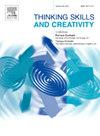Longitudinal association between physical activity and creative self-efficacy in adolescents: Mediating role of psychological resilience
IF 4.5
2区 教育学
Q1 Social Sciences
引用次数: 0
Abstract
Creative self-efficacy (CSE), an individual’s belief in their ability to produce creative outcomes, is fundamental to adolescents’ creative development. Embodied cognition theory and current empirical evidence link physical activity and creativity. Yet, the longitudinal association between physical activity and CSE remains poorly understood. This study investigated the longitudinal association between physical activity and CSE in adolescents, with a particular focus on the mediating role of psychological resilience. A total of 751 Chinese adolescents (48.20 % boys, Mage=16.27) completed self-report questionnaires on physical activity, psychological resilience, and creative self-efficacy at three time points over 12 months. Using both cross-lagged panel modeling (CLPM) and random intercept cross-lagged panel modeling (RI-CLPM), we differentiated between-person from within-person effects. Results showed that physical activity was significantly associated with CSE over time. Notably, at the within-person level, psychological resilience was a significant mediator, with sensitivity analyses demonstrating the relative robustness of the mediation effect. These findings not only advance embodied cognition and stress adaptation theories by illuminating a time dynamic mechanism among physical activity, psychological resilience, and creative self-beliefs, but also highlight the potential practical implications of promoting physical activity and resilience-building programs to foster adolescents’ creative self-beliefs. Finally, the limitations and future directions of this study are discussed.
青少年体育活动与创造性自我效能的纵向关联:心理弹性的中介作用
创造性自我效能感(CSE)是一个人对自己产生创造性成果的能力的信念,是青少年创造性发展的基础。具身认知理论和目前的经验证据将身体活动与创造力联系起来。然而,身体活动与CSE之间的纵向关联仍然知之甚少。本研究探讨了体育活动与青少年CSE之间的纵向关系,特别关注心理弹性的中介作用。共751名中国青少年(48.20%男生,16.27)在12个月的三个时间点完成了身体活动、心理弹性和创造性自我效能的自我报告问卷。使用交叉滞后面板模型(CLPM)和随机截距交叉滞后面板模型(RI-CLPM),我们区分了人与人之间的影响和人与人之间的影响。结果显示,随着时间的推移,体力活动与CSE显著相关。值得注意的是,在个人层面上,心理弹性是一个显著的中介,敏感性分析显示了中介效应的相对稳健性。这些发现不仅通过阐明体育活动、心理弹性和创造性自我信念之间的时间动态机制,推进了具身认知和压力适应理论的发展,而且强调了促进体育活动和心理弹性建设项目对培养青少年创造性自我信念的潜在现实意义。最后,讨论了本研究的局限性和未来发展方向。
本文章由计算机程序翻译,如有差异,请以英文原文为准。
求助全文
约1分钟内获得全文
求助全文
来源期刊

Thinking Skills and Creativity
EDUCATION & EDUCATIONAL RESEARCH-
CiteScore
6.40
自引率
16.20%
发文量
172
审稿时长
76 days
期刊介绍:
Thinking Skills and Creativity is a new journal providing a peer-reviewed forum for communication and debate for the community of researchers interested in teaching for thinking and creativity. Papers may represent a variety of theoretical perspectives and methodological approaches and may relate to any age level in a diversity of settings: formal and informal, education and work-based.
 求助内容:
求助内容: 应助结果提醒方式:
应助结果提醒方式:


